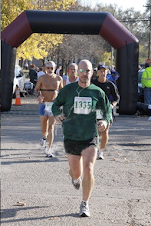I just finished reading Born to Run by Christopher McDougall, a book that centers on the Tarahumara Indians who live in the Copper Canyons of Mexico. The Tarahumara are an ancient tribe of runners, ultramarathoners really, who run unfathomable distances in what amounts to makeshift shoes assembled from pieces of rubber tires and leather straps. McDougall delves into the evolution of man, from his humble beginning as homo erectus to today, and he explores scientific evidence that indicates man is actually a born runner. We're not the fastest or strongest of the earth's creatures, but we have the genetic ability to run long distances without growing tired. This ability allowed early man to track down prey; after a while, other animals must stop to regulate their body temperature and their breathing while man can keep going and going. This ability (called "persistence hunting") eventually allowed homo erectus to beat out Neanderthals in the evolutionary race to the finish.
As a side note to that information, part of McDougall's research discusses how these tribespeople can run such long distances in what amounts to their bare feet. Turns out, the concept of barefoot running isn't new. In fact, evidence in the book shows that more injuries have occurred to the lower leg (including plantar fasciitis, ankle injuries, etc.) since the advent of the modern running shoe than in the years prior to its invention. Seems shoe manufacturers make unsuspecting runners believe they need all that padding and cushioning when, in fact, Mother Nature has taken care of all of that for you. The foot is a design marvel, which includes an elaborate arch system, a spring-loaded Achilles heel and more bones than any other part of the human body.
For years, I've bought into the mindset that I needed the right shoe to keep me going. My feet tend to pronate (turn inward) when I run, so I've purchased motion-control shoes that help. My ankles occasionally roll, so I've bought shoes with more padding on the outer edges to keep my feet stable. I've spent hundreds (okay, probably thousands) of dollars on shoes that were supposed to keep me on the roads and out of the hospital.
Turns out, I had the right shoe all along—or at least the right basic equipment—without ever spending one cent.
My gift this Christmas has allowed me to put what I learned about barefoot running into practice. Full-fledged barefoot running isn't feasible here in Indiana in December. Snow under my bare toes wouldn't feel too great and I think they'd kick me out of the gym if I chose to go barefoot on the treadmill. That leaves two options I've found to simulate the feel of the barefoot running while still covering my tootsies—the Vibram Five Fingers (basically a glove for the feet) and the Nike Free.
I'll be honest and tell you the Five Fingers is a little too weird for my taste. It probably works great, but the design reminds me of those novelty toe socks my sisters used to get for C
 hristmas every year. My vanity won't allow me to wear them...yet. So I settled for the Nike Free 5.0, basically a shoe (that actually looks like a shoe—see it there on the right?) that simulates barefoot running through minimal padding and a deep groove system in the tread that allows the shoe to flex freely in all sorts of directions. (Here's a YouTube video from Nike that explains it better than I can: Nike Free video)
hristmas every year. My vanity won't allow me to wear them...yet. So I settled for the Nike Free 5.0, basically a shoe (that actually looks like a shoe—see it there on the right?) that simulates barefoot running through minimal padding and a deep groove system in the tread that allows the shoe to flex freely in all sorts of directions. (Here's a YouTube video from Nike that explains it better than I can: Nike Free video)I've run in the shoes twice so far—once for five miles on the treadmill and today, outside, for another four. The early verdict? The shoes are amazing. I've experienced a few blisters, which I assume, over time, will callous up. But despite that one minor setback, the shoes have also made me really change how I run. Instead of using long strides, which cause the foot to land on the heel (an unnatural activity, I've read, which can lead to plantar fasciitis), the Nike Free forces you to keep your feet underneath you. To be comfortable, you tend to use shorter, quicker steps, landing in the middle of your foot (where your arch is) instead of the heel. Even after only two runs, I've noticed my feet feeling...stronger somehow. The shoe forces your toes to grip more, especially the couple of times today where I ran through some packed snow.
So enough on this for now. My wife's sick of me talking about this stuff anyway.
Thanks for reading and happy running.


My friend Rachel just recommended that book to me. I need to put it on my list.
ReplyDelete